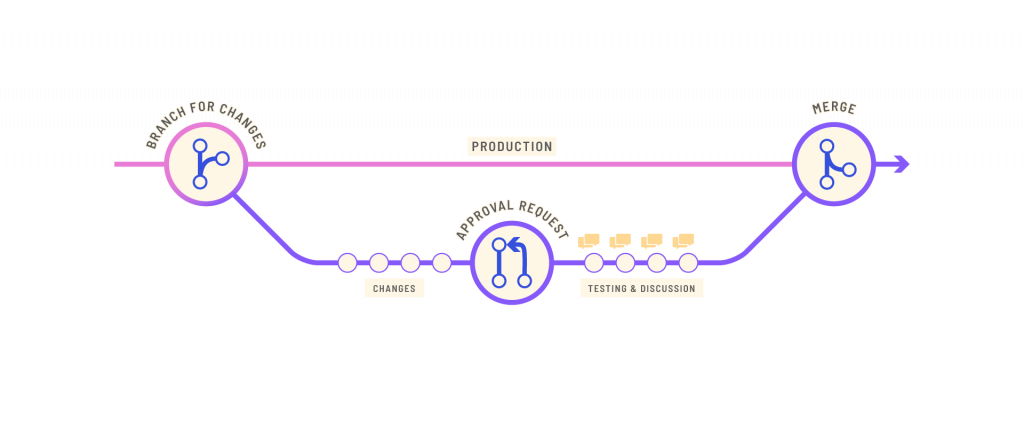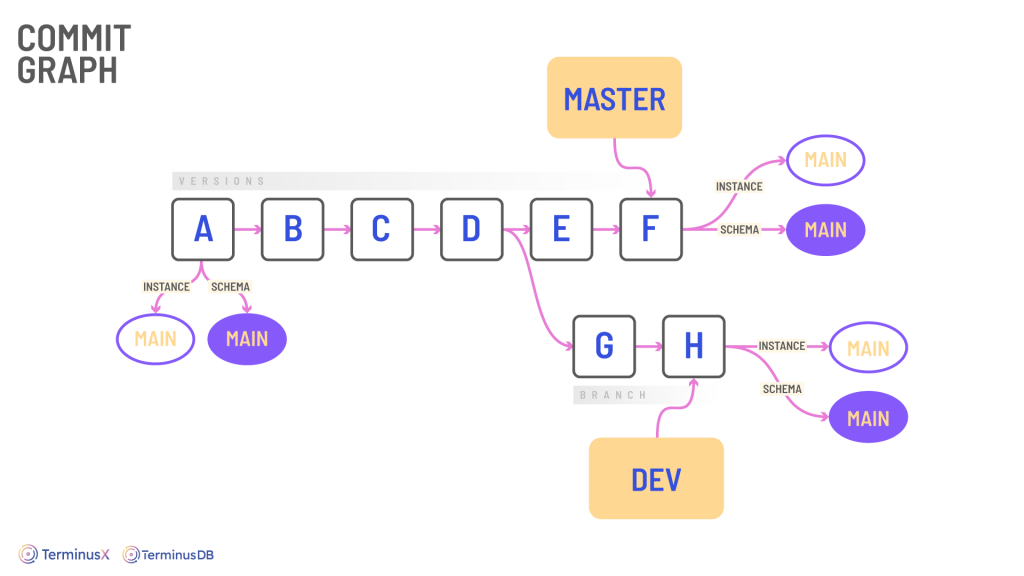A new year brings new hope, new challenges, and new opportunities. We wish you all the success in 2022 and thought we’d kick things off with an article focused on the top 5 application development trends you need to think about for 2022.
1. Version control = collaboration, and it should be in your data layer

Version control perhaps doesn’t excite many when it comes to the initial thought, but when you look at how it revolutionized the software development world, it is a wonderful thing.
Version control is more than simply being able to roll back to a previous version of your code, document, or in our case, database, it’s about collaboration. Utilizing your team’s skills in harmony to build better, faster, and more innovatively.
Whether building apps, features, operational enhancements, or gaining business intelligence, the ability to fork, branch, and merge your data so that data teams and software developers can collaborate and work concurrently is a key trend for application building in 2022.
The DataOps movement, which aims to remove silos and improve collaboration, is also gaining traction and will become even more entrenched within enterprise operations in 2022. The only real way to work collaboratively between teams is to add version control to your data layer.
TerminusDB is at the forefront of collaborative, version-controlled databases and data management tools, but others are arriving in the market, such as Dolt that pitches itself as a marriage of two familiar concepts, Git and MySQL. Another MySQL compatible data platform is PlanetScale that enables users to branch their data, make schema changes, and check for and resolve conflicts prior to merging back into main.
The need for collaboration in your data layer is a trend that will continue to ascend beyond 2022 to help builders work together to continue to shape the future of commerce.
2. Knowledge graph backed apps for the future - user interactions are going beyond search and retrieval and into a new world
Former Snowflake CEO, Bob Muglia recently said that the general trend for 2022 will be the emergence of knowledge graphs and that the modern data stack will build knowledge graphs to embed business logic inside the database.
This isn’t a new trend, it’s just picking up speed. Last year, Gartner predicted that by 2025, graph technologies will be used in 80% of data and analytics innovations. MarketsandMarkets’ report on graph databases, predicts graph databases will grow from $1.9 billion in 2021 to $5.1 billion in 2026 becoming one of the fastest-growing areas in the database market.
Enterprise organizations will expedite this growth as they recognize the power of graph technologies to make better use of their data. Data mesh, data fabric, use cases such as 360 views, and auditing will also fuel this growth.
3. JSON continues to rule the roost for app devs

JSON continues to be the data interchange format of choice, particularly with web and app developers. According to Web Technology Surveys, JSON-LD is used by 41.4% of all websites, growing from 34.5% the previous year.
The biggest advantage in favor of JSON is that it can be handled natively by JavaScript using JSON.parse() and JSON.stringify() and these have been supported in web browsers for over 10 years.
Due to its lightweight nature, seamless integration with JavaScript, and that almost all major languages have some sort of library or built-in functionality to parse JSON strings, JSON is easy for programmers to work with.
MongoDB’s rapid rise has had a hand in JSON’s lofty position, but more importantly, the fact that companies like Google, Twitter, and Facebook provide APIs exposing their data in JSON format has driven acceptance and usage of JSON amongst the programming and development community.
4. Building audit into applications from inception becomes more prevalent

Auditing applications and software builds is important to ensure data quality, accuracy, and security, it can also help with license and regulatory compliance.
In many instances of application development, an audit comes later, mainly due to the workload of building and working to deadlines, so the fine-tuned auditing comes later. But is delaying your application audits causing harm in the long run?
In many app builds, the requirements can be in flux as the application takes shape and users start experimenting and subsequently finding things they’re not quite happy with. By building audit capabilities into applications from inception, the application needs and development can proceed along parallel lines to give you a greater chance of improving the quality of the product that is being developed.
As an immutable database, TerminusDB has always facilitated auditing from the very outset of any data development. With the ability to see who’s changed what and when and compare differences, TerminusDB provides visibility so audits can be provisioned internally or externally and used to improve all aspects of the development process, from security to user experience.
5. Modular low-code development systems like Firebase and TerminusX grow up and become full development suites with much of the tooling delivered
Low-code development is one to look out for in 2022. With the speed of digitization, accelerated by the pandemic, a faster and more economically viable alternative to bespoke build is needed. Microsoft estimates that five hundred million apps will be required over the next five years and Gartner forecasts that by 2024, 65% of apps will be low-code. Those are big numbers.
Firebase is Google’s low-code development suite enabling quick app build and release. With a modular build, it lets users create serverless, secure apps that can scale. With lots of features to help with bugs and app usage, it’s become an extremely popular development platform, in May 2021, Google claimed to have 3 million monthly active apps using Firebase.
Hot on the tail of Firebase is Supabase, which is positioning itself as the open-source alternative. It is a Postgres database enabling users to create a backend with authentication, instant APIs, with real-time subscription and storage. With over 26,000 stars on GitHub, Superbase is another low-code development suite that people are adopting to build faster.
TermimusX is also a low-code development toolkit, combining features like document SDKs, operational APIs, authentication, and a document graph database. It enables you to quickly build powerful data-intensive applications.
6. Did we say 5? Here’s a bonus trend: Intelligence first - Building apps with AI in mind

Here are a few statistics from IDC:
- By 2025, 60% of companies will use some form of remote expert to support operational staff with AI and knowledge management.
- By 2023, 25% of global banks will use AI-based sentiment analysis to improve customer experience on current and future products and services.
- By 2026, B2B companies will use AI interactions and analytics technology to deliver deeply personalized journey engagement, eliminating 40% of marketing and sales human touchpoints.
Although not set in stone, these predictions show that AI and ML are not just buzzwords. The growth is apparent everywhere, and while many are seeking to jump on the bandwagon, there is no denying that AI can provide a real competitive advantage, especially if you’re building data-intensive applications.
Building the app with a view to layering on AI is a trend that is continuing to soar. With the visibility of AI across the media and use cases being well-publicized, developers are building apps with machine learning in mind from the outset.
By building intelligence first, what we mean is building knowledge first and that is started by getting the semantics right. With the right semantics, those working with the data will have a clear, defined set of rules to understand and follow.
TerminusDB and TerminusX use extendable and flexible schemas to blueprint application builds, and supplement these plans with metadata to provide context. When the inevitable happens and someone wants to use AI and ML for analytics and predictions, data scientists and BI analysts can understand the data thanks to the schema and metadata to perfect their machine learning training and ultimately generate more accurate business insights and predictions.
